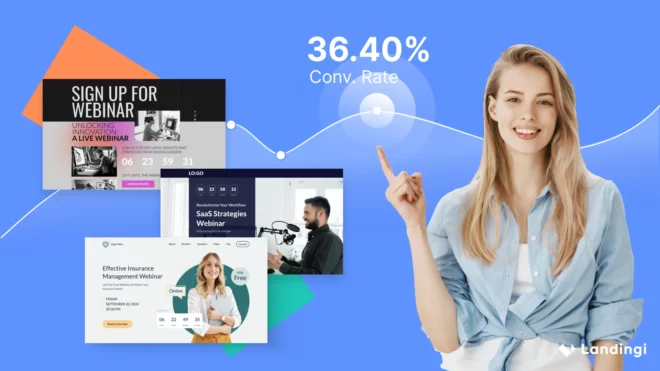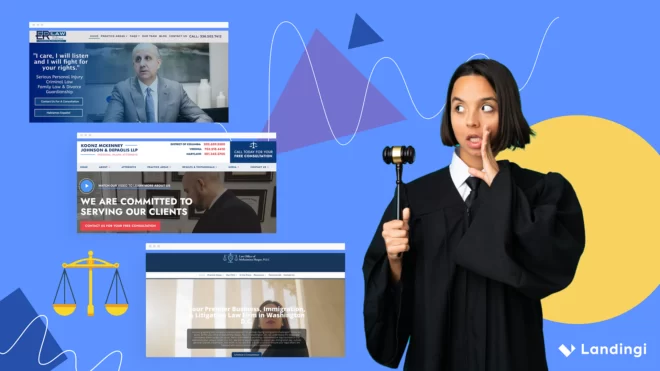Remember this “Minority Report” scene, where Tom Cruise’s character sees personalized ads while walking through the city?
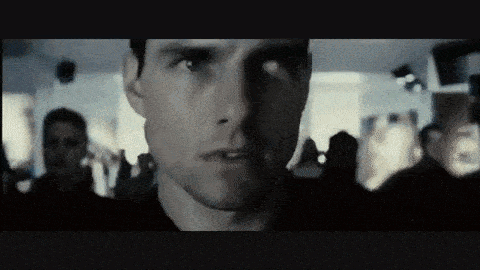
At the time, the idea of ads that “know you” was far-fetched and unrealistic. This was 2002; we didn’t even have Facebook or the iPhone yet.
But then technology took a few leaps forward, and voila! Personalization became a vital part of marketing – and not just because it, to use Seth Godin’s words, gives us a chance to differentiate at a human scale.
No; the real reason for the rise of personalization is, it’s incredibly profitable. Here are a few numbers to show you what we mean:
- E-mails featuring recipients’ personal names, titles, interests, etc have a 152% higher open rates.
- In a HubSpot study, personalizing Calls to Action in content increased response rates by 42%,
- 94% (!) of businesses say personalization is critical to their success.
Impressive, right?
What’s less impressive is that as many as 70% of all businesses still under-utilize personalization as a marketing tool. They’re still stuck in sub-optimal marketing strategies, leaving bundles of money on the proverbial table as a result. And although using standard landing page templates is a good and relatively safe way to go, it’s always good to test some new ideas.
You don’t want that to be your story – and by the time you finish this article, it won’t be.
Why?
Because you’re about to see how 4 companies – Toyota Dobrygowski, Tokeo, Prowly and Pixers – exploded their conversions by personalizing their landing pages. The strategies they used will help put you and your business ahead of the pack, giving you an almost-unfair advantage against your competition.
Now get ready to learn the points from this article and see your conversion rates run laps around your competitors. Our first case study is…
Case Study: Tokeo – Personalization by Profession
Tokeo – a Polish brand – was made as a way for businesses and individuals to get consultations and advice from experts in different fields. It was essentially a mix between Quora and Clarity.FM, only local – and its creators needed 300 experts on-board to run the project’s pilot.
To this end, they created a “one-size-fits-all” landing page that allowed users to sign up as experts. Then they started driving organic and paid traffic via paid ads, social media, word-of-mouth and e-mailing.
The initial conversion rate was a lackluster 8.5%. This wasn’t bad, considering that not all the traffic was targeted – but the brand decided it could do better, and we agreed.
As a result, we decided to take the same elements the original pages had – the hero shot, the explainer video, the simple sign-up form, the 3-point list of benefits – and make a bunch of targeted pages aimed at specific experts instead.

As you can see, we came up with 11+ landing page variations. Since Landingi allows users to duplicate pages, this only took us around an hour; we simply copied the original page (highlighted above), changed the Hero Shot and rearranged the elements.
Once we started driving traffic to these pages, the difference was readily apparent. Some pages – like the one for doctors, which got a 13% conversion rate – did better.

Others, like the variant made for teachers, did significantly better (30%+ conversion rate):
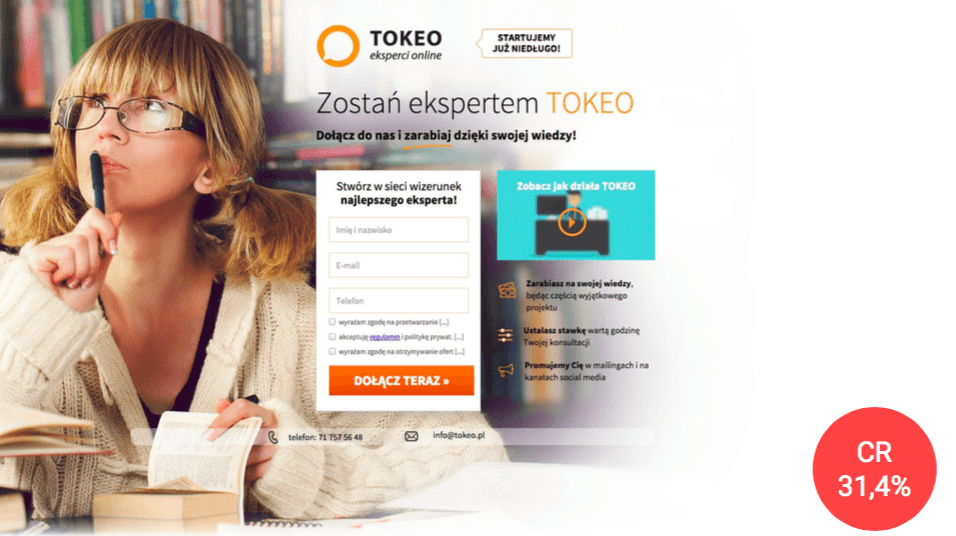
And one particular page – the one made for digital marketers – did 700% (!!!) better than the original “one-size-fits-all” version!
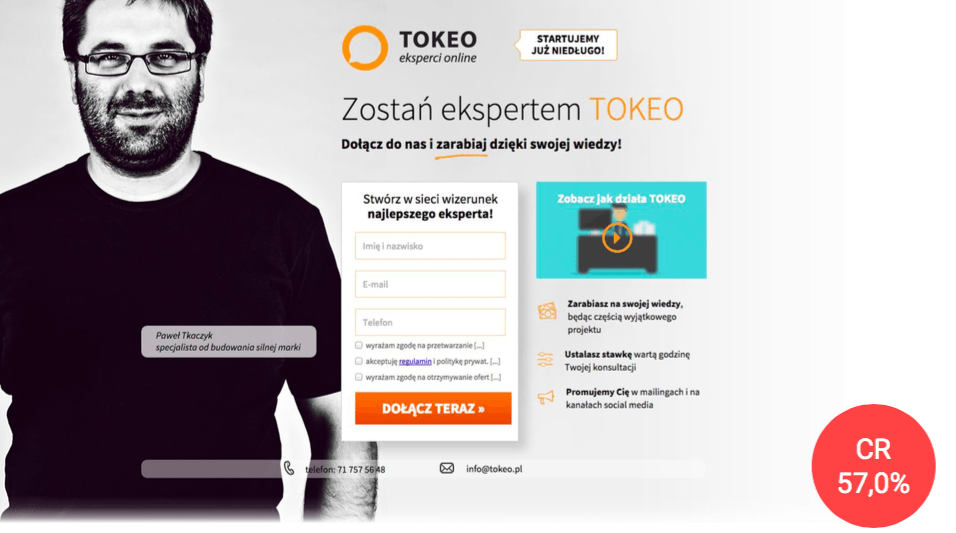
Some of these pages did significantly better than others – but what matters is that all the personalized pages we made had a 40%+ conversion advantage over the original page.
Regretfully, the project never ended up going past the pilot stage – but it’s a pretty definitive example of targeted pages sending conversions through the roof.
Now, if you’re a marketer, you know that not all leads are created equal. Okay, these 11+ pages boosted Tokeo’s landing page conversions… But what will it do for a business’s sales; for its bottom line?
We’re glad you asked. Our next case study – Toyota Dobrygowski – is a dual-location car dealership. Here’s what personalized landing pages did for their business.
Create landing pages without programming skills with Landingi!
Case Study 2: Toyota Dobrygowski – Personalization by Sales Rep
A common question is whether personalization works when you don’t necessarily have data about your prospective buyers. This was the case for Toyota Dobrygowski: an automotive dealer operating in the towns of Lubin and Wroclaw.
The company’s traffic sources were diverse, their marketing strategy – complex, and their experience with landing pages – low. As a result, they decided to give personalization a whirl without segmenting potential customers. Instead, they created 5 landing pages personalized for the dealers working for the company.
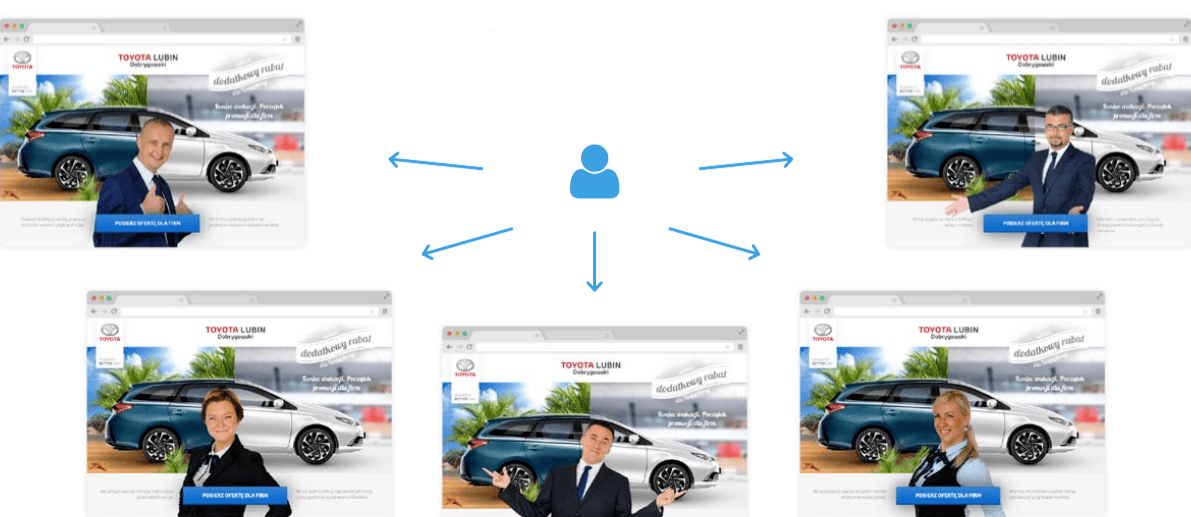
With these pages, the focus was on adding a “human touch” in the form of a hero shot and a real-life employee of the business. There aren’t stock photos; these are actual images of Toyota Dobrygowski’s staff. The button is always located center, immediately in front of the shots, to emphasize relationships and not just products.
One thing the Case Study showed is that smiling women do indeed convert better than men. We tried all kinds of tweaks, but the ladies’ photos consistently performed better than the gents’.
The second and most important thing we learned is that this kind of personalization can improve sales. Consumers reported enjoying the experience of speaking to the same person they saw online in person or on the phone. On their side, Toyoda Dobrygowski confirmed that their sales went up when they started using these pages – even as the rest of the marketing mix stayed the same.
This case study is interesting for marketers who can’t, or won’t, segment their customers. If you don’t have enough data, time or resources to make landing pages targeted at your customers, you can still add a touch of brand-side personalization – and see results.
It’s also interesting to see how a traditionally offline business, like this Toyota dealership, can see a real uptick in sales and profits with personalized landers.
Now, what if you’d like an easy (and broad) way to personalize – but aren’t able to do so to the extent that Tokeo did in our first case study?
There’s an ap solution for that – and here’s how our next case study, Prowly, did it…
Case Study 3: Prowly – Personalization by Country
A survey of 6,000 consumers found that people want to shop locally – but also expect their business to be digitally savvy. This is a sticking point for many businesses, who are either unable to emphasize their local background or incompetent at digital marketing.
One of our clients, Prowly, wanted to avoid the same fate before making their expansion to several European countries. Sweden and Germany were first in line – so the brand decided to engage local customers and get some intel with these country-specific graphics and pages:
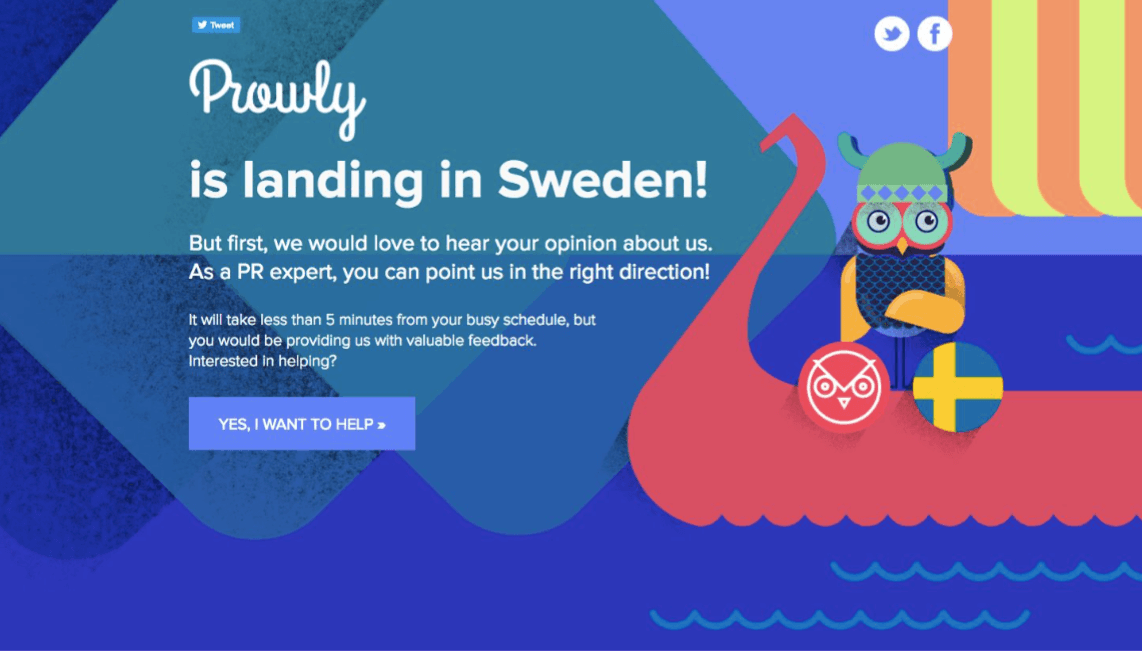
And here’s the German version:
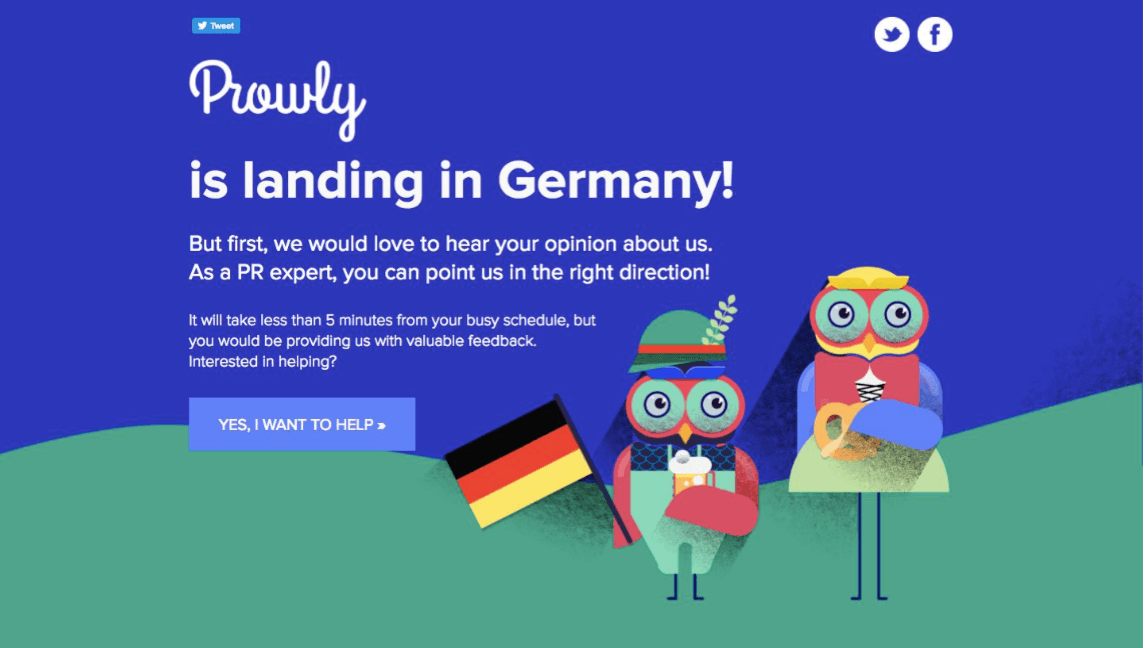
As you can see, these pages are targeted and use a little tongue-in-cheek humor to get users’ attention. The German owls are holding a pretzel and drinking beer; the Swedish owl is equipped with viking gear. The idea was not to over-play the “local” card, but rather to show potential customers that Prowly is prepared to invest in catering to their country.
The results were strong – and here’s another detail that definitely helped Prowly’s team get the feedback they needed from this landing page:
This little “bribe”, in the form of 15% and 30% discounts, was a big help. The previous 2 case studies offered no bonuses for signing up and still converted well – but as a rule, you want to give people something on a landing page.
That “something” is called a lead magnet in the marketing industry, and Prowly’s did a great job of using one to maximize their conversions.
The next case study didn’t – but they did personalize in a way that was different from the previous 3 examples. Here’s what we mean.
Case Study 4: Pixers – Personalization by segment
Our 4th client, Pixers, is an interior personalization business. Since their whole business model is based on individualized products, making sure their landing pages are tailored to different customer segments was a priority. To this end, different landing pages were created.
These landing pages were targeted at different customer segments and different traffic sources. For example – one marketing campaign targeted LinkedIn users who were business owners, H.R. department decision makers, etc. Everyone who was responsible for interiors in their office or store was in this target audience.
To cater to them specifically, this page was created:
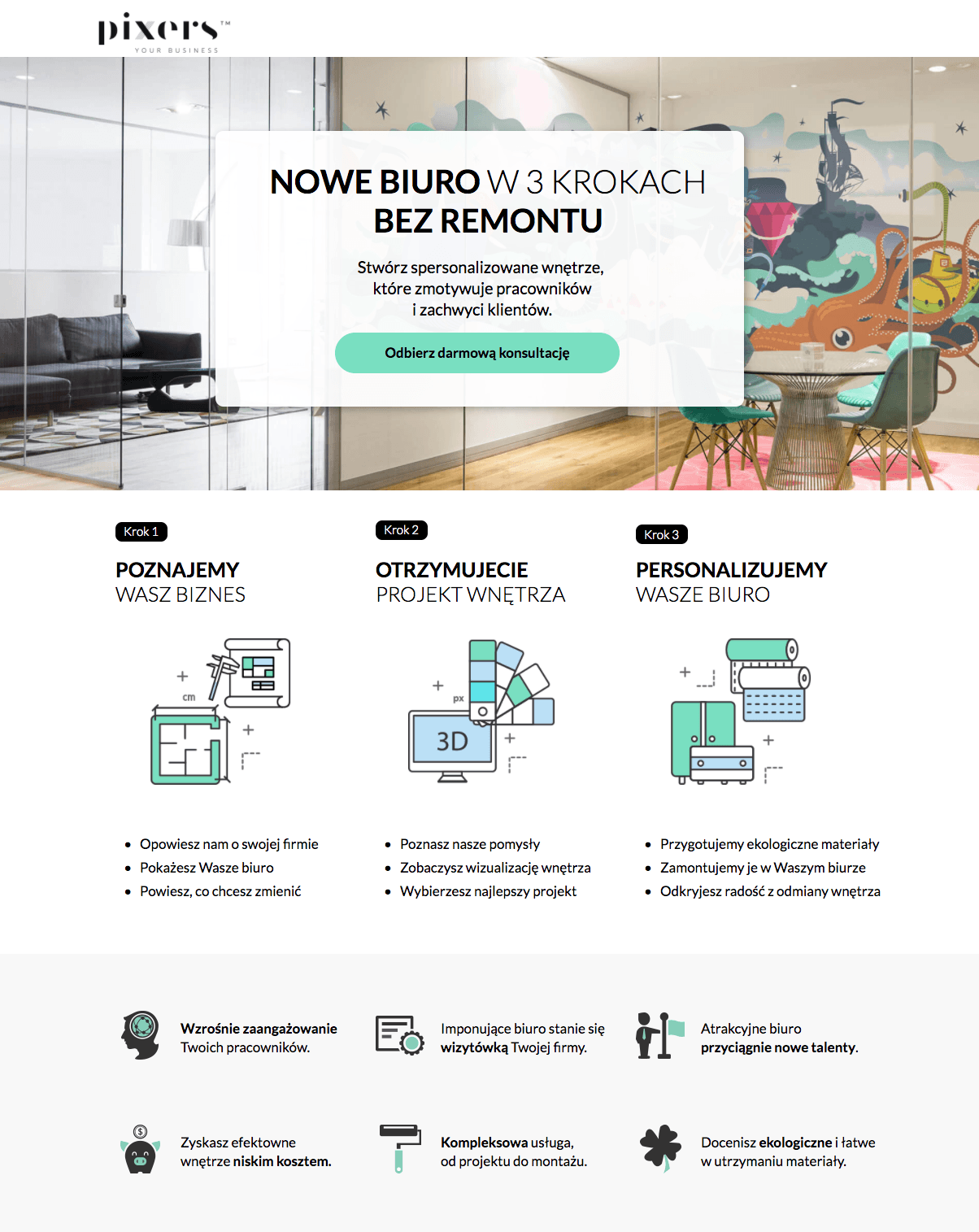
The design of the page is B2B-oriented, with clean lines; solid colors; copy that heavily features the benefits of the furniture. This is a markedly different angle from what was used to target potential B2C customers. For an example of the latter, here’s the page that was created for cat lovers as a sub-segment:
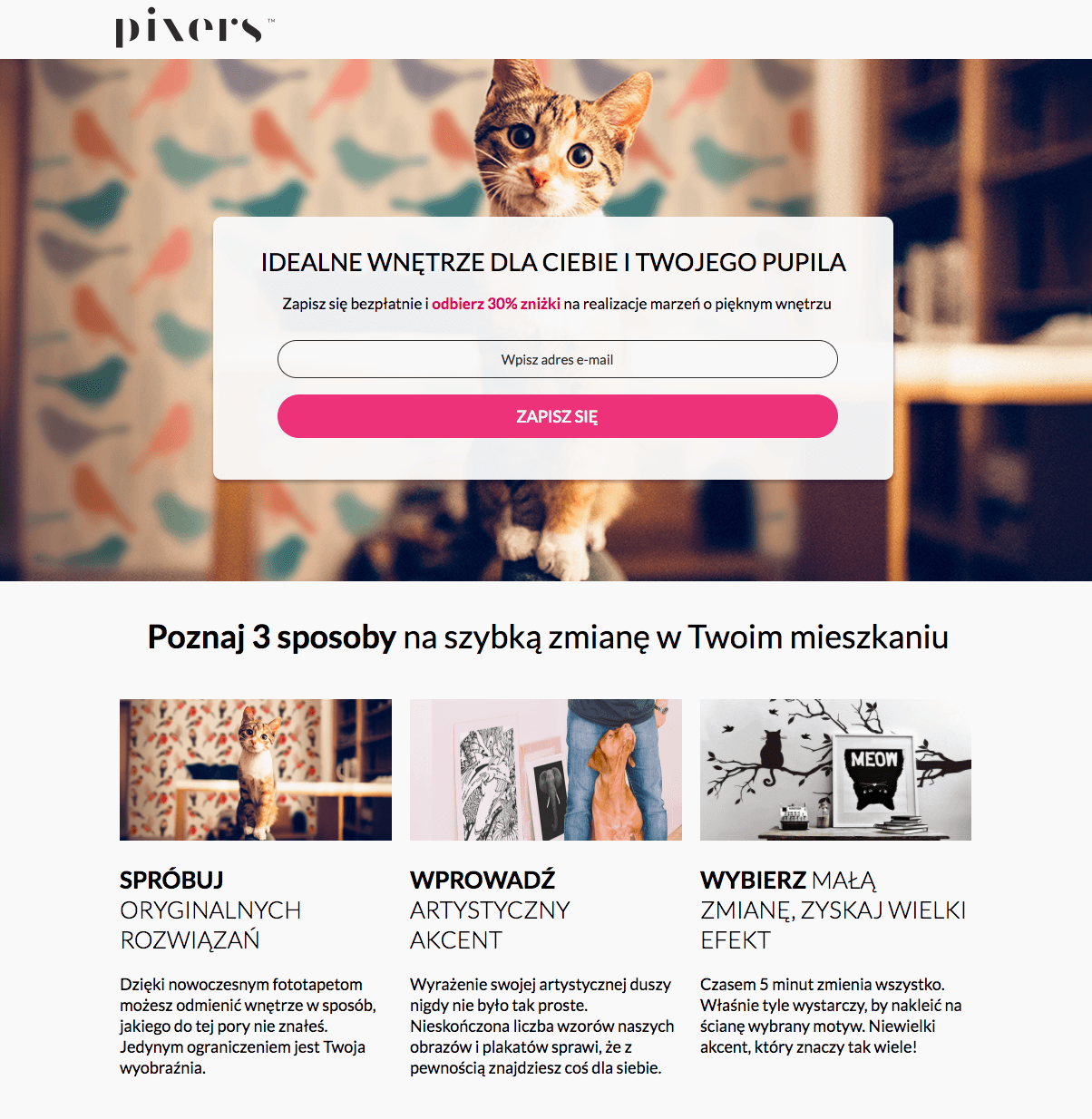
The page above is distinctly B2C, with entertaining cat images, a more creative page design and a focus on benefits instead of features.
Segmenting by niche and end user interests in this way has allowed Pixers to get up to 15% conversion with B2C customers and 5% in the B2B segment. Considering the absence of a lead magnet and the high quality of the leads, these are excellent results that show the viability of personalizing landing pages this way.
Now we’ve seen all 4 case studies – so let’s get back to what really matters. Your business, your landing pages and your sales process. Here’s…
What All Of This Means For You
The first takeaway is simple: no matter how you slice it, personalization works. When Interra published that personalized marketing converts up to 4 times better, they weren’t just being hypey. Targeted pages are highly effective; end of story.
The second takeaway is that personalization doesn’t have to be difficult. Neil Patel emphasized first and last names, as well as geolocation, as the most important parameters to know – and these are all easy to collect.
The third takeaway is that when you’re picking a landing page builder, it’s really important to use one that allows for easy split-testing and page copying. You want to be able to experiment with personalization without having to worry about coding, creating entirely new pages, etc. In this sense, our clients were all fortunate to be using our service, and not one like OptimizePress, where running an A/B test is difficult.
Now, would you like to know how you can replicate the results that our clients had, improve your conversions and gain more sales in the process?



